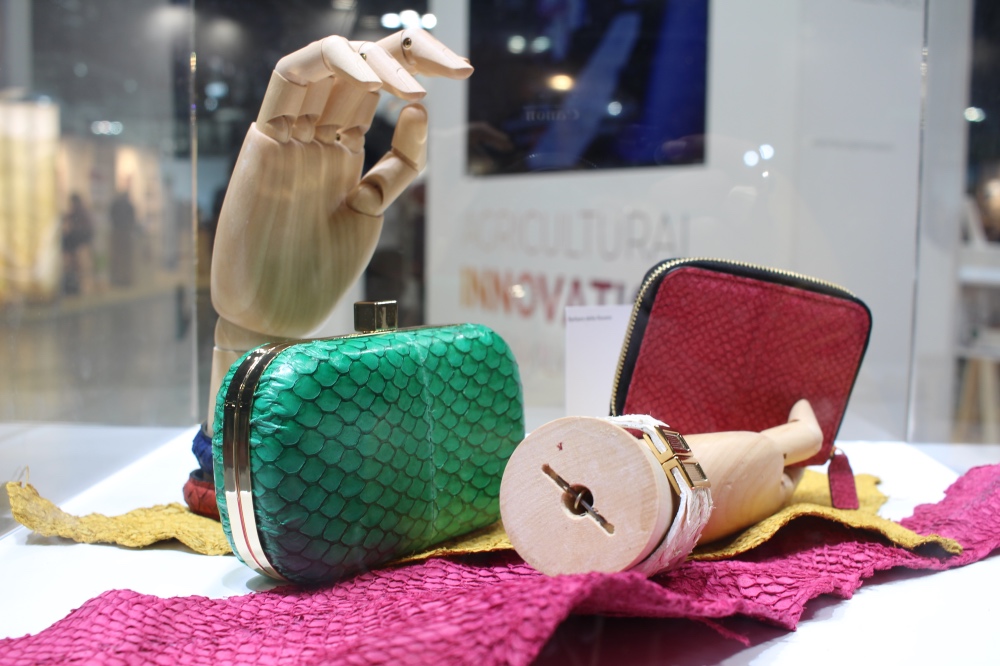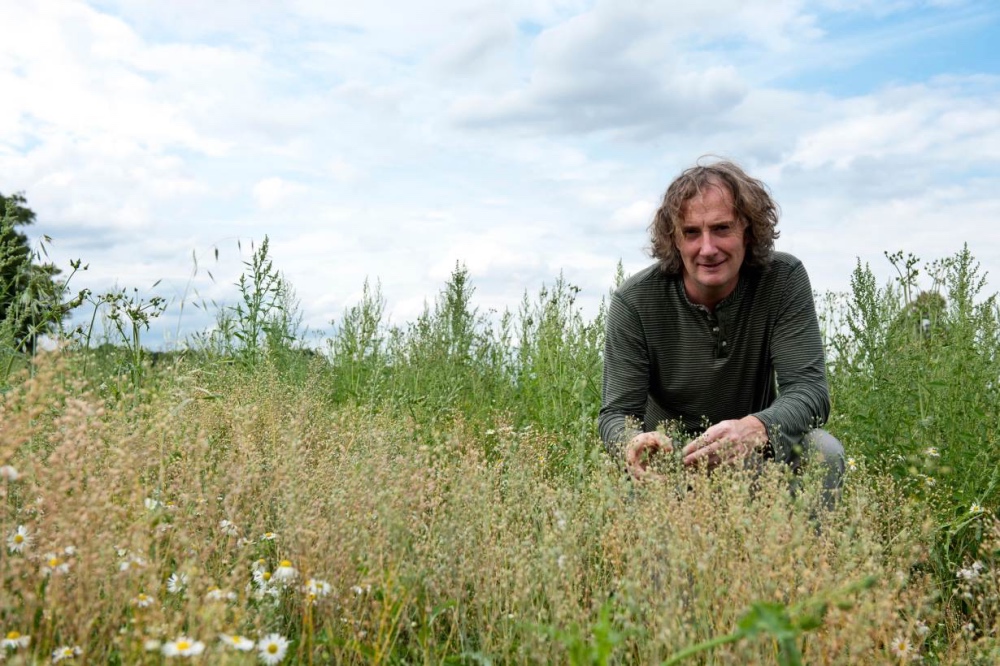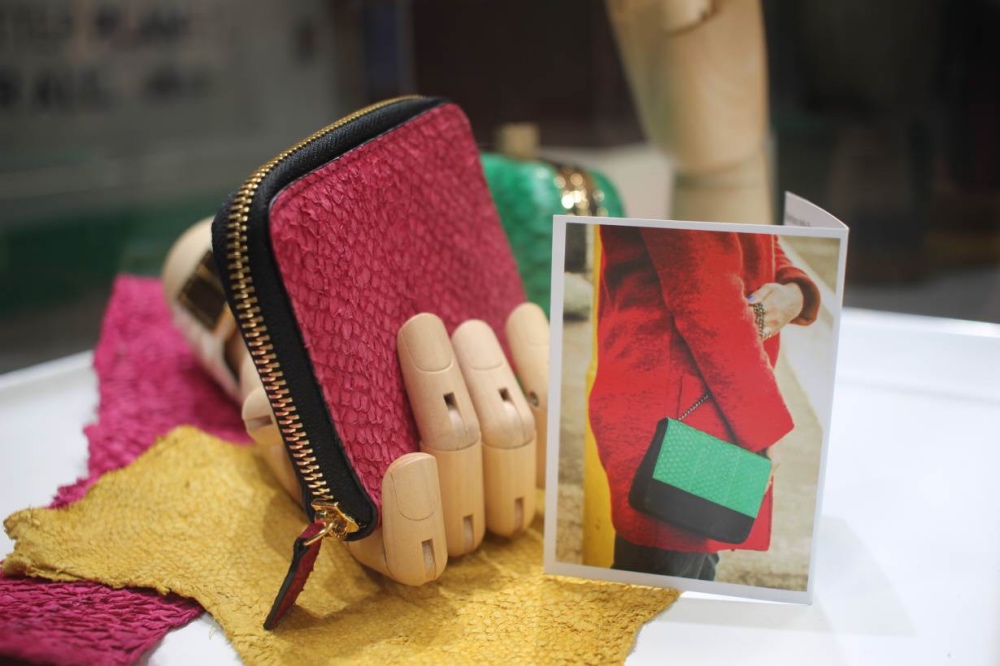
THIN LEI WIN, of Thomson Reuters Foundation, reports on some fishy fashion…
Rome, Italy
Thomson Reuters Foundation
With a third of the world’s oceans over-fished and global consumption at an all-time high, the time seems ripe for forward-thinking ventures like US-based Good Catch, which aims to provide “seafood without sacrifice”.
The company’s first products were launched in February and recreate the texture and flavour of tuna, the world’s most popular fin fish, by blending six legumes with algae oil.

Luxury handbags made with fish skin leather by Brazilian designer Barbara della Rovere, seen at the Seeds & Chips food summit in Milan, Italy, on 6th May. PICTURE: Thin Lei Win/Thomson Reuters Foundation.
Such plant-based offerings could spell big changes, both for consumers in rich countries and in parts of the developing world where people many struggle to get enough nutritious food.
Besides pressures from growing populations and degrading ecosystems, climate change is expected to hit fisheries hard, said Vera Agostini, deputy director of fisheries and aquaculture at the United Nations’ Food and Agriculture Organization.
“Overall [climate] projections for fisheries show decreased catch potential in the tropical regions and increases in northern latitudes.”
– Vera Agostini, deputy director of fisheries and aquaculture at the United Nations’ Food and Agriculture Organization.
“Overall [climate] projections for fisheries show decreased catch potential in the tropical regions and increases in northern latitudes,” she told the Thomson Reuters Foundation.
“Sadly the areas that rely the most on fish, which is developing countries, are projected to see decreases.”
There will also be shifts in the distribution of fish, including their appearance in places where they have not been seen before, she added.
Consumption of fish is at record levels, according to the FAO, at 20.2 kilograms per person compared to nine kilograms in 1961.
But the world’s craving for fish also offers opportunities, said Good Catch CEO Chris Kerr.
“We eat between 200-300 different types of sea creatures, compared to about 30 types of land animals,” he said.
“In this, we have an enormous ability to be creative – both technologically and in employing the best culinary arts.”
Good Catch, founded by chef brothers Chad and Derek Sarno, is planning to expand to Britain early next year and launch new frozen appetisers including plant-based crab, fish burgers and white fish.

Plant scientist Johnathan Napier at the first genetically-modified camelina field trial in Harpenden in south east England, in 2014. PICTURE: Provided by Rothamsted Research.
Other startups like California-based BlueNalu are growing mercury-free seafood cells in labs to ensure a stable supply chain in the face of over-fishing, illegal fishing and the effects of warming oceans.
BlueNalu’s president and CEO Lou Cooperhouse said it had developed a natural process to grow the muscle cells that are a major component of fish without genetic modification.
“We’re focused on fin fish as a first broad category, and it’s our next objective to go on to crustaceans like lobster and crab and, ultimately, molluscs,” he said.
The company expects to test its products on the market within two to three years and start large-scale production in five years.
Until cell-based seafood reaches supermarket shelves, retailers and consumers will have to rely on farmed fish, which already accounts for half of global consumption, the FAO says.
Levels of omega-3 fatty acids, essential for human health, have fallen in farmed fish since over-fishing concerns spawned a switch from feed rich in oily fish to soy and other alternatives.
In response, Johnathan Napier and his team at Britain’s Rothamsted Research, an agricultural science centre, have genetically modified plants whose seeds produce the two key acids that make up omega-3.
“If we can use a land-based source of fish oils as a way of augmenting or adding to the stuff from the oceans, then we can relieve the pressure on the oceans,” he said, adding that the end result would also be far more affordable.
After 20 years of research and five years of field trials, Napier plans to apply for regulatory approval in North America.
In Europe, GMO crops remain controversial, with very few varieties authorised for growing and some countries like France banning their cultivation, citing environmental risks.
The FAO says innovation is crucial to maintaining fish stocks and can also help struggling fishing communities increase their incomes.
An FAO symposium in Rome that coincides with World Fisheries Day on Thursday is showcasing how fish parts that would otherwise be discarded could be transformed into high fashion.

Luxury handbags made with fish skin leather by Brazilian designer Barbara della Rovere, seen at the Seeds & Chips food summit in Milan, Italy, on 6th May. PICTURE: Thomson Reuters Foundation/Thin Lei Win.
Brazilian-Italian designer Barbara della Rovere has worked since 2016 with fishermen’s wives in Kenya and southern Brazil to transform fish skin into luxurious leather bags and cuffs.
“They treat the skins, and all the remains – bones, flesh and scales – become fertiliser for the local farmers,” she said.
“So the entire byproducts that would [normally] be thrown away are used. It’s 100 per cent sustainable.”
Fish skin is tougher than cow leather because the fibres run in multiple directions, creating a more solid and durable product.
Some of the women involved in the project were previously illiterate but can now read and have their own source of income, she said.
“I’m not an NGO – I still want to sell my bags. But nowadays, you have to think of sustainability.”





